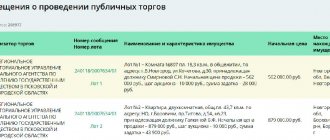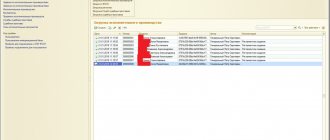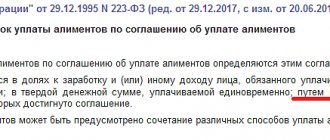What is a property inventory?
When the court makes a decision to collect funds from the debtor to pay off existing debts, enforcement proceedings are introduced.
Debts in such cases can be different: loan debts, non-payment of utilities, alimony debts, as well as other financial encumbrances. If the debtor is unable to pay off debts with cash, an inventory of the debtor’s property is made for the purpose of its subsequent sale. Enforcement proceedings, as well as an inventory of property, are carried out by employees of the Federal Bailiff Service - bailiffs.
The legal regulation of this procedure is carried out by Federal Law No. 229 “On Enforcement Proceedings”, as well as Federal Law No. 118 “On the Bailiff Service”.
When the court makes a decision to collect funds from the debtor to pay off financial obligations (in the form of a writ of execution, a court order, as well as a resolution to initiate enforcement proceedings against the defaulter), the defaulter is notified by registered mail against signature.
From this moment enforcement proceedings against the debtor begin. He has a 2-week period for voluntary repayment of existing debt. If the defaulter deliberately does not pick up the registered letter, then these deadlines do not apply to him.
In what cases is property described?
The reason for conducting an inventory of the debtor’s property, as mentioned above, is the issuance of a court decision to collect funds from the debtor to repay the debt.
Until the court makes an appropriate decision, bailiffs will not carry out actions to arrest, inventory and confiscate the property of the defaulter. The debtor's property can be described and then sold only after the court makes a decision to begin enforcement proceedings.
An inventory of property, and accordingly its arrest, occurs in the following cases:
- when it is necessary to ensure the safety of the debtor’s existing property. This must be done so that in the future this property can be sold to pay off debts to creditors;
- to execute a court decision that orders the confiscation of property from the debtor;
- to enforce a court decision ordering the seizure of the debtor's property.
In addition, an inventory of property is made in the following situations:
- the property itself is the subject of litigation;
- the owner of the property is the plaintiff in civil proceedings;
- the debtor-defendant refuses to pay the debt under the judgment.
However, an important point must be taken into account: an inventory of the debtor’s property is not made if the writ of execution states that an amount of up to 3,000 rubles inclusive is to be collected. Such cases do not concern the seizure of collateral property, as well as a cash account.
Get a free consultation
How should a bailiff act according to the law?
When meeting with the debtor, he is obliged to present his identification and resolution, and carry out enforcement actions within the framework of the law. Even if he is forced, he cannot raise his tone, threaten, or behave incompetently. After all, the debtor, for his part, can write a complaint against him or file a lawsuit in order to protect his honor and dignity. Such cases in court, as practice shows, are often resolved in favor of the debtor.
If necessary, consult a litigation lawyer.
Author of the article
How does the procedure work?
First, the bailiff checks the debtor's accounts. If the required amount to repay the debt is not available, then the bailiff has the right to visit the debtor to make an inventory of the property.
Typically, bailiffs carry out an inventory of property at the place of registration or place of actual residence.
Bailiffs can make an inventory of the debtor's property on weekdays from 6.00 to 22.00. In special cases, bailiffs have the right to carry out the procedure on weekends and holidays, as well as at night.
If the debtor interferes with the performance of official duties of the bailiffs (does not open the door, refuses to let the bailiffs into the residential premises), then in this case they have the right to forcefully enter the premises, inspect and describe the property. With the written permission of the senior bailiff, the bailiff may force the door.
When making an inventory of property, the presence of witnesses (at least two) is required. In this case, the debtor does not have to be present during the inventory. This was done intentionally so that the debtor would not interfere with the implementation of enforcement proceedings. It turns out that it is possible to describe, seize, and also sign the inventory report without the presence of the debtor-defendant.
Participants in the procedure for inventorying the debtor's property are:
- bailiff;
- the debtor or to represent him (relatives of the debtor can act as representatives: parents, spouse);
- witnesses (at least two);
- the person who receives the debtor's property that is under arrest or storage.
The bailiff begins his work with an inventory of the debtor's property.
Important! Property that does not belong to the debtor, but is owned by third parties (relatives, spouse), is not included in the inventory report and is not subject to seizure. To do this, interested parties must provide evidence that the property is their property (for example, checks, sales agreement) and does not belong to the debtor. Property whose owner is unknown is also included in the inventory act.
Also, during the procedure for inventorying and seizing the debtor’s property, a preliminary assessment is made. If the total amount of the inventory exceeds 30,000 rubles, the property must be assessed by an appraiser. Less than 30,000 rubles - bailiff. The debtor has the right to disagree with the assessment of the value of the seized property, about which a corresponding entry is made in the inventory report. In this case, the debtor can file a complaint with the court within 10 days, and also hire an appraiser at his own expense.
The seized property must correspond to the amount of debt the debtor owes to creditors. For example, if a debtor has a debt of 15,000 rubles to creditors, then the bailiff has no right to describe property for a large amount.
The final stage of making an inventory of the debtor's property is the preparation of a special legal document - an inventory act. The inventory report includes the following information:
- date, time and place of the inventory;
- Full name and passport details of the plaintiff and defendant;
- Full name and passport details of the persons participating in the inventory;
- Full name and passport details of the person to whom the debtor’s things are transferred for storage (if there is one);
- contents of the inventory act;
- a list of items of the debtor’s property that are included in the inventory, with a description of their characteristics (quantity, color, condition, etc.);
- the approximate estimated cost of items, as well as the timing of their sale. The total amount of seized property.
The property inventory report is drawn up in 2 copies: for the bailiff, as well as for the debtor-defendant. All participants in the property inventory procedure must sign the document.
From this moment on, the debtor’s seized property, contained in the inventory act, cannot be sold, donated, transferred to third parties, or left as an inheritance.
Upon completion of the inventory of the debtor's property, an entry is made in the act that the person who accepted the seized property was explained his rights and obligations. The specified person bears full responsibility for the safety of the property entrusted to him.
The illegal actions of a bailiff can be challenged in court.
Should the bailiff be allowed into the apartment or not?
In addition, the bailiff must obtain permission from a higher authority to allow him to invade someone else's apartment. And the senior bailiff, in turn, does not really like to make unnecessary problems for himself. He deals exclusively with those matters that may cause discontent in society or affect the political situation.
By creating obstacles for the bailiff on the way to your apartment, the credit debtor creates the opportunity for employees of this authority to commit a number of legal errors. This will be an excellent weapon against bailiffs during court hearings, when filing a complaint with the prosecutor's office and other governing bodies that have more rights compared to the bailiff.
It is important to understand that bailiffs do not come just like that. Most often they are sent by angry management. Also a lever for taking action is a complaint from a creditor. A wise debtor will make it clear to the bailiff that he will cause much more problems than the complaint received.
But there is no need to be afraid of the local police officer. He has much fewer rights than a bailiff. And he can break into an apartment only in three cases: the fact of committing a murder, when organizing the rescue of victims of a crime, and when hiding a fugitive from prison.
The most important thing is to remember that your home is inviolable and you need good reasons to break into it.
4.Rights of the bailiff and debtor
Bailiff's rights:
- bailiffs can make an inventory of property at the place of registration or place of actual residence of the debtor;
- The permitted time for the procedure is weekdays from 6.00 to 22.00. In “emergency” cases, this condition may be violated.
- bailiffs have the right to open the debtor's doors to allow access to the home and conduct a search, and then an inventory of the property. Such actions can be carried out in the presence of witnesses, as well as a local police officer;
- In their work, bailiffs can make requests to banks about the accounts of the defaulter, as well as make requests to Rosreestr and other organizations to obtain information about the debtor’s real estate;
- in addition to the amount of the debt, the bailiff collects an enforcement fee, the amount of which is 7% of the amount of the debt;
Debtor's rights:
- the debtor has the right to be present during the property inventory procedure;
- When making an inventory of property, the debtor can stipulate which things can be included in the inventory act in the first place. The bailiff is obliged to satisfy this demand of the debtor. However, if the amount received from the sale of the specified property is not enough, then the inventory of the property continues until the debt burden is fully repaid;
- the debtor has the right to hire an appraiser at his own expense if he does not agree with the amount of valuation of his property.
Get a free consultation
Powers of bailiffs
According to current legislation, representatives of executive bodies have the right to come to the debtor to draw up an inventory of his property without warning. Restrictions on the visit of bailiffs relate only to time - the interval for their work is from 6 am to 10 pm (most often, employees of the executive body stand on the debtor’s doorstep early in the morning).
To carry out their work of debt collection, bailiffs have the right to receive personal information from defendants and check documents for identification.
Important: many people naively believe that they have the right not to allow bailiffs to enter their doorstep. At the same time, we must not forget that the appearance of representatives of executive bodies on the doorstep of a house is not accidental. The powers of the bailiffs include forced entry into the premises where the debtor lives or is registered. In this case, the arriving bailiff service officers must comply with three conditions:
- To open an apartment, the team arriving to inventory the property must have a warrant (sanction) from the head of the unit;
- There must be an appropriate decision of the judicial authority, which states permission to enter the premises of the person who has a debt and to draw up an inventory of items;
- When opening the apartment where the offender lives, outsiders must be present and brought in as witnesses.
It is the observance of these three conditions that simultaneously excludes a violation of the constitutional norm on the inviolability of the home.
What are they describing?
According to the law, the following groups of property of the debtor can be described and seized:
- real estate. However, inclusion of the debtor's real estate in the inventory has a number of features. These nuances will be discussed below;
- luxury goods, including jewelry of various types. As a rule, this group includes things of high value, as well as cultural significance: works of art (paintings, figurines, manuscripts, etc.), antiques, souvenirs. All these things have no practical use, but due to their high cost they can be sold to pay off existing debts.
- Appliances. There are also nuances here, we will consider them below.
- securities: shares, bonds, etc.;
- vehicle.
According to the Civil Procedure Code of the Russian Federation (Article 446), the following categories of property of the debtor are not subject to recovery in enforcement proceedings:
- housing of the debtor, if it is the only one for him and his dependents. If the debtor owns several apartments, one of them (or several) can be described and then sold at auction. It is worth considering that the amount of debt must be commensurate with the value of the property sold. That is, due to a small debt, expensive property is not sold.
- land plots on which the debtor's real estate is located;
- food products, in almost unlimited quantities. The law prescribes criteria for assessing the “need” of food products. Their amount must be at least the subsistence level for each family member. The exception is if it is a product intended for commercial sale, that is, purchased by the debtor for sale or to hide available funds;
- items of necessary furniture, household items, including hygiene items;
- personal achievement items. This includes certificates, awards, cups, memorial signs, etc.;
- Kids' things;
- pets, livestock, as well as buildings and premises necessary for their maintenance;
- seeds for planting;
- vehicles and fuel for it, if they are intended for the performance of professional activities (taxi drivers, drivers, etc.). Also, vehicles specially equipped for people with disabilities (cars for disabled people) are not subject to arrest;
- items and means necessary for disabled people (for example, a wheelchair);
- household appliances in a single copy. Bailiffs have the right to describe and seize all other equipment.
If there is nothing to describe?
Quite often, bailiffs are faced with a situation where the debtor does not have the funds to pay off debts, as well as property that can be sold. Such defaulters do not own real estate (or, if they have it, it is the only one), the car is not registered to the debtor, and the bailiff did not find any securities in his possession.
How is this situation resolved? Article 46 of the Federal Law “On Enforcement Proceedings” says: the bailiff has the right to return the writ of execution to the claimant and ends this proceeding with a special resolution. The defaulter-defendant is subject to the restrictions imposed on him (accounts, property, etc.).
However, this is not the end of the debt recovery story for the debtor. Debt obligations remain. And the creditor-plaintiff, if an improvement in the financial situation of the debtor is detected, can again turn to the bailiffs to start proceedings. This will restart the entire process.
When the arrest is lifted
The seizure of property is lifted:
- after the debt has been repaid by the debtor himself;
- in case of satisfaction of the claim for the exclusion of certain things from the encumbrance;
- if the bailiff made procedural errors and his actions were appealed.
Within 5 days after the decision to lift the arrest is made, the defaulter must be notified of this. It happens that bailiffs “forget” to remove the encumbrance. Then it must be removed in court.
Sources:
Data Bank of Enforcement Proceedings
Definition of the bailiff department
What happens next? (Seizure and sale of property)
The sale of the debtor's property occurs in the following way:
- through special stores (if these are, for example, household appliances, furniture, jewelry, etc.);
- through organized auctions. Here the debtor's property exceeding 500 thousand rubles is sold. As a rule, this concerns the sale of the debtor’s real estate (apartment, house, land), as well as property of high value (securities, car, antiques, etc.).
If a bailiff seizes property worth less than 30 thousand rubles, the debtor can agree to independently sell this property.
Seized property that is subject to sale is usually valued at average market prices.
For example, a similar used television is offered for sale from 3 thousand to 5 thousand rubles. Consequently, the defaulter’s TV can be valued at 4 thousand rubles. This scheme for calculating the value of property is approximate and is not always applied. If the debtor does not agree with the proposed valuation of his property, he can challenge it and involve an appraiser in the work. But he will do it at his own expense.
If seized property put up for sale does not find a buyer, then after a month its value will be reduced by 15%. In another month – 25% lower than the original cost.
Is it possible to return seized property put up for sale?
Theoretically, it’s possible. But if the total amount of the debt differs significantly from the amount of the property being redeemed, then the debtor will not be able to return the desired item. The defaulter will need to repay the existing debt in full. Then the thing dear to the debtor will return to its owner again. And yet, if the property has been sold, then it will not be possible to return it.
Drawing up an act
This document must contain the following information:
- address of the place of compilation;
- exact time;
- Full name of witnesses;
- Full name of the debtor and the claimant;
- Full name and position of the person who made the inventory;
- Full name of the person who is responsible for the safety of the property;
- document details;
- a list of all seized property indicating weight, estimated value and special notes;
- the period during which the property can be purchased through auction.
How does bankruptcy help?
Getting into a debt hole is not a tricky thing. It is much more difficult to get out of it. If you cannot cope with the debt burden on your own, then it is better to turn to specialists. The individuality of each situation, a large number of legal procedures, court hearings can greatly complicate the already stressful life of the debtor. Moreover, the higher the amount of financial obligations, the more attractive the advantages of the bankruptcy procedure seem.
The undoubted and main advantage of bankruptcy is the write-off of debts (full or partial), which certainly outweighs the restrictions from its completion.
It is better to entrust the solution of financial problems to specialists who have proven themselves in their field.
To summarize, we can draw the following conclusions:
- An inventory of the debtor's property is understood as a legal procedure, the purpose of which is to obtain funds through the sale of the property of the obligated person. This procedure is carried out by specially authorized persons - bailiffs.
- The procedure for inventorying the debtor's property begins with the initiation of enforcement proceedings, i.e. By the tribunal's decision. The legal basis for this is a writ of execution, a court order, as well as a resolution to initiate enforcement proceedings against the defaulter.
- An inventory of the debtor's property, as a rule, takes place at the place of his registration or actual residence. The permitted time period for the work of bailiffs to inventory property is working days from 6.00 to 22.00.
- Participants in the procedure for inventorying the debtor's property are: bailiff; the debtor or his representative; the person receiving the debtor's property for safekeeping; witnesses.
- In the process of making an inventory of the debtor's property, a preliminary assessment is made. If the total amount of the property inventory is up to 30 thousand rubles. – the assessment is made by a bailiff; if more than 30 thousand rubles. – an appraiser is hired. The amount of the preliminary assessment will later be included in the inventory report of the debtor’s property.
- Not all of the debtor's property is subject to inclusion in enforcement proceedings. The inventory does not include: the debtor’s only home; the land plot on which the debtor's house is located; food (at least the subsistence level for each family member); necessary furniture, household and hygiene items; items of personal achievements (cups, certificates, medals, etc.); Kids' things; domestic animals and livestock necessary for farming (including facilities for their maintenance); seeds for planting; vehicles and equipment necessary for the professional activities of the debtor; vehicles and items necessary for a disabled debtor; necessary household appliances in a single copy.
- If the debtor does not have property that could be included in the inventory of property, then the bailiff has the right to return the writ of execution to the claimant and completes this proceeding with a special resolution. However, this does not mean the termination of debt obligations and the writing off of the debtor's debts. If his financial situation improves, the creditor-plaintiff can again turn to the bailiffs to start proceedings.
- The final stage of making an inventory of the debtor's property is drawing up a property inventory act. It must be drawn up and signed in a clearly regulated form by the participants in the procedure. The finished inventory act is drawn up in 2 copies: for the bailiff and for the debtor-defendant. All participants in the property inventory procedure must sign the document.
Get a free consultation





